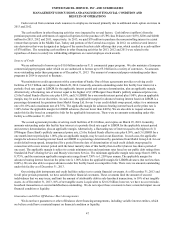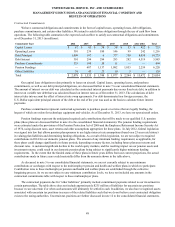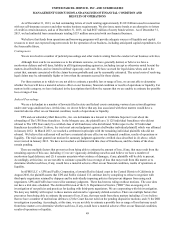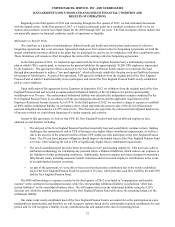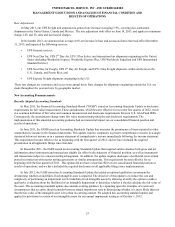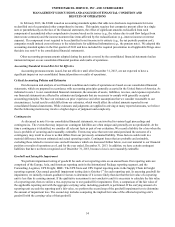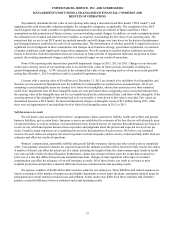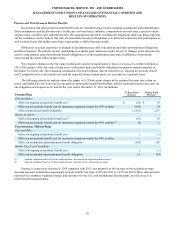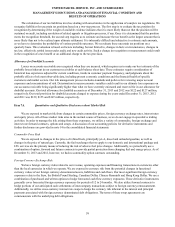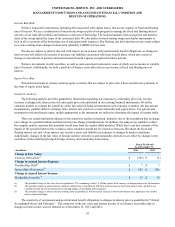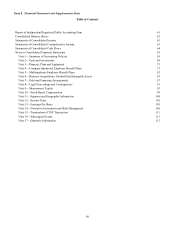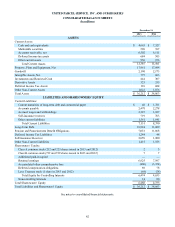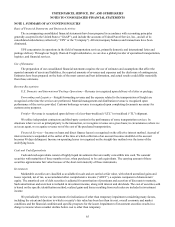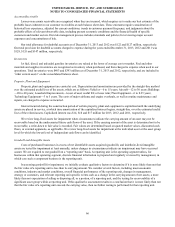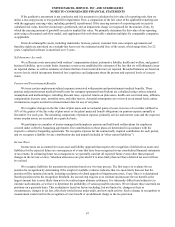UPS 2013 Annual Report Download - page 69
Download and view the complete annual report
Please find page 69 of the 2013 UPS annual report below. You can navigate through the pages in the report by either clicking on the pages listed below, or by using the keyword search tool below to find specific information within the annual report.UNITED PARCEL SERVICE, INC. AND SUBSIDIARIES
MANAGEMENT'S DISCUSSION AND ANALYSIS OF FINANCIAL CONDITION AND
RESULTS OF OPERATIONS
57
Depreciation, Residual Value and Impairment of Fixed Assets
As of December 31, 2013, we had $17.961 billion of net fixed assets, the most significant category of which is aircraft. In
accounting for fixed assets, we make estimates about the expected useful lives and the expected residual values of the assets,
and the potential for impairment based on the fair values of the assets and the cash flows generated by these assets.
In estimating the lives and expected residual values of aircraft, we have relied upon actual experience with the same or
similar aircraft types. Subsequent revisions to these estimates could be caused by changes to our maintenance program, changes
in the utilization of the aircraft, governmental regulations on aging aircraft and changing market prices of new and used aircraft
of the same or similar types. We periodically evaluate these estimates and assumptions, and adjust the estimates and
assumptions as necessary. Adjustments to the expected lives and residual values are accounted for on a prospective basis
through depreciation expense.
We review long-lived assets for impairment when circumstances indicate the carrying amount of an asset may not be
recoverable based on the undiscounted future cash flows of the asset. If the carrying amount of the asset is determined not to be
recoverable, a write-down to fair value is recorded. Fair values are determined based on quoted market values, discounted cash
flows or external appraisals, as applicable. We review long-lived assets for impairment at the individual asset or the asset group
level for which the lowest level of independent cash flows can be identified. The circumstances that would indicate potential
impairment may include, but are not limited to, a significant change in the extent to which an asset is utilized, a significant
decrease in the market value of an asset and operating or cash flow losses associated with the use of the asset. In estimating
cash flows, we project future volume levels for our different air express products in all geographic regions in which we do
business. Adverse changes in these volume forecasts, or a shortfall of our actual volume compared with our projections, could
result in our current aircraft capacity exceeding current or projected demand. This situation would lead to an excess of a
particular aircraft type, resulting in an aircraft impairment charge or a reduction of the expected life of an aircraft type (thus
resulting in increased depreciation expense).
In 2013, 2012 and 2011, there were no indicators of impairment in our property, plant and equipment, and no impairment
charges were recorded in any period.
Fair Value Measurements
In the normal course of business, we hold and issue financial instruments that contain elements of market risk, including
derivatives, marketable securities, finance receivables, other investments and debt. Certain of these financial instruments are
required to be recorded at fair value, principally derivatives, marketable securities, pension assets and certain other
investments. Fair values are based on listed market prices, when such prices are available. To the extent that listed market
prices are not available, fair value is determined based on other relevant factors, including dealer price quotations. Certain
financial instruments, including over-the-counter derivative instruments, are valued using pricing models that consider, among
other factors, contractual and market prices, correlations, time value, credit spreads and yield curve volatility factors. Changes
in the fixed income, equity, foreign exchange and commodity markets will impact our estimates of fair value in the future,
potentially affecting our results of operations. A quantitative sensitivity analysis of our exposure to changes in commodity
prices, foreign currency exchange rates, interest rates and equity prices is presented in the “Quantitative and Qualitative
Disclosures about Market Risk” section of this report.
Income Taxes
We make certain estimates and judgments in determining income tax expense for financial statement purposes. These
estimates and judgments occur in the calculation of income by legal entity and jurisdiction, tax credits, benefits, and
deductions, and in the calculation of certain tax assets and liabilities, which arise from differences in the timing of recognition
of revenue and expense for tax and financial statement purposes, as well as the interest and penalties related to these uncertain
tax positions. Significant changes to these estimates may result in an increase or decrease to our tax provision in a subsequent
period.
We assess the likelihood that we will be able to recover our deferred tax assets. If recovery is not likely, we must increase
our provision for taxes by recording a valuation allowance against the deferred tax assets that we estimate will not ultimately be
recoverable. We believe that we will ultimately recover a substantial majority of the deferred tax assets recorded on our
consolidated balance sheets. However, should there be a change in our ability to recover our deferred tax assets, our tax
provision would increase in the period in which we determined that the recovery was not likely.


